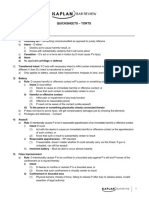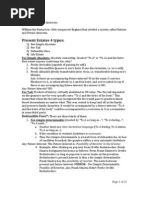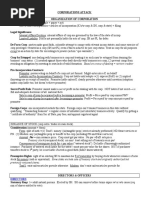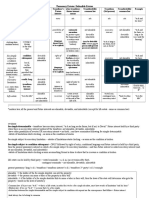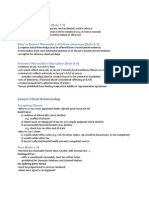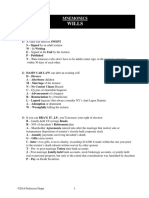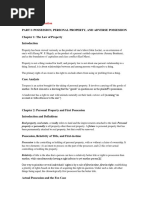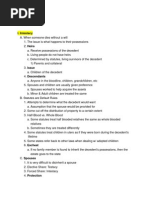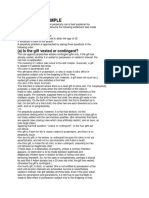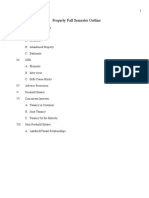Barbri Lect Property
Barbri Lect Property
Uploaded by
Juliane Ashley MurphyCopyright:
Available Formats
Barbri Lect Property
Barbri Lect Property
Uploaded by
Juliane Ashley MurphyCopyright
Available Formats
Share this document
Did you find this document useful?
Is this content inappropriate?
Copyright:
Available Formats
Barbri Lect Property
Barbri Lect Property
Uploaded by
Juliane Ashley MurphyCopyright:
Available Formats
Estates in Land
I. Present Estates
1. Fee Simple Absolute Absolute ownership Created To A or To A and his heirs Best present possessory o Freely devisable (capable of passing by will), o Freely descendible (passes to ones heirs, if one dies intestate), o Freely alienable (alienationto be transferable inter vivos) Is there an accompanying future interest? o NO! It is ABSOLUTE ownership 2. Fee Tail Virtually abolished Depended on grantors use of specific languageto A and the heirs of his body Passed directly to lineal blood descendants, no matter what! Idea historically: desire to keep land in the family Is there an accompanying future interest? o Maybe, reversion in O or remainder in some third party 3. Defeasible Fees ** a. Fee simple determinable i. To A so long as To A during To A until (1) Grantor must use CLEAR DURATION LANGUAGE (2) If condition is violated, forfeiture is AUTOMATIC ii. Is there a future interest? (1) Yes, possibility of reverter in grantor
Frank Sinatra to Orville Redenbacher so long as popcorn is never made on the premises
(2) Present interest is fee simple determinable (3) Possibility of reverter by Frank Sinatra, if condition violated (4) F.S.D.P.O.R. (fee simple determinable with possibility of reverter)
** Frank Sinatra did not Prefer Orville Redenbacher
Fee simple subject to condition subsequent i. To A, but if X happens, grantor reserves right to reenter and retake (1) CLEAR DURATIONAL LANGUAGE, AND (2) Carves out RIGHT TO REENTER ii. Not automatically terminated, but can be cut-short at grantors option, if condition occurs iii. Bobby Brown of estates its my prerogative to terminate iv. IS there a future interest? Yes, Right of Entry (aka power of termination) c. Fee Simple subject to Executory Limitation i. To A, but if X occurs then to B ii. To Justin Bieber, but if JB ever performs music on the premises then to Joe Jonas iii. Automatically forfeited if condition occurs, but works in favor of another NOT grantor (shifting executory interest) 4. Life Estate a. Explicit life-time terms: To A for life (A would be life tenant) b. The romantic estate c. Has future interest of reversion at end of As life, then to O and Os heirs d. Life estate pur autre vie (for life of another) To A for life of B e. Is there a future interest?
b.
If held by O, reversion Or, remainder when future interest is held by a third party LIFE TENANT AND WASTE DOCTRINE i. Must not commit waste! ii. Must not do anything that effects future interest holders iii. Three kinds (1) Voluntary Waste (affirmative) Overt conduct that causes a cost in value (2) Permissive Waste (neglect) When land is allowed to fall into disrepair Life Tenant must MAINTAIN Blackacre (3) Ameliorative Waste Life tenant must not engage in conduct that will ENHANCE propertys value, unless all future interest holders consent
i. ii.
II. FUTURE INTERESTS
A. FUTURE INTERESTS CAPABLE OF CREATION IN O, THE GRANTOR 1. Possibility of Reverter FSDPOR 2. Right of Entry (Power of Termination) Fee simple subject to condition subsequent 3. Reversion catch all Arises whenever grantor has something leftover B. FUTURE INTERESTS CAPABLE OF CREATION IN TRANSFEREES 1. Remainder a. Patient future interests, waits for present estate to end before it takes b. REMAINDERS NEVER FOLLOW DEFEASIBLE FEES c. To A for life, then to B B has a remainder d. Either vested or contingent e. Vested in two circumstances: i. When created in a known taker ii. And not subject to a condition precedent To A for life then to B no pre-requisite f. Contingent when: i. Created in as yet unknown takers ii. Subjected to conditions precedent To A for life, then to Bs first child. (B currently has no children contingent remainder) To A for life, then, if B graduates from college, to B RULES THAT LIMIT CERTAIN CONTINGENT REMAINDERS [1] Destructibilitycontingent remainder would be destroyed if it were still contingent when preceding estate ended. ABOLISHED TODAY VESTED REMAINDERS Created in a known taker that is not subject to condition precedent Ask, what kind of vested is it? (1) Indefeasibly vested remainders (BEST KIND) when its taker is known and not subject to any conditions. To A for life, then to B (2) Vested Remainder subject to complete divestment [vested remainder subject to complete defeasance] remainderman exists, not subject to condition precedent, subject to a condition subsequent. Some eventuality that if it manifests will divest
(remove) remainderman of his interest. To A for life, then to B, but if B dies under 25 to C. If B dies under 25, Bs estate loses everything. (3) Vested remainder subject to Open remainder is vested in a group, category, or class of takers; at least one of whom is eligible to take. To A for life, then to Bs children. A is alive, B has two children, C and D. C & D have vested remainder subject to open. Always ask, is this class open or closed? open when others can still join closed when no one else can join; whenever any member can demand possession. 2. Executory Interests take effect by cutting short another or benefitting from anothers forfeiture, are either: a. Shifting always follows a defeasible fee and cuts short someone other than O. To A, but if B returns from Canada next year, to B o B has a shifting executory interest B is capable of interrupting A. o Why doesnt B have a remainder? BECAUSE remainders never follow defeasible fees. (Remainders are patient, typically follow life estates) o A has a fee simple subject to Bs shifting executory interest b. Springing cuts short O, the grantor. O conveys: To A, if and when he marries When A does get married, he has the power to cut off Os interest RULE AGAINST PERPETUITIES Certain future interests are void if there is a chance that the interest might vest more than 21 years after the death of a measuring life. A compromise position. Do not want land tied up forever and ever Step 1: Classify Future Interest RAP applies only to certain contingent remainders, executory interests, and vested remainders subject to open RAP never applies to future interests in O (possibility of reverter, reversion, etc) RAP wont apply to indefeasible vested remainders, subject to complete defeasance Step 2: What has to happen for future interest holder to take? Step 3: Find a measuring life An entity alive at the date of the conveyance, whose life or death is relevant to the conditions occurring. Step 4: Will we know for sure within 21 years of the death of that measuring life if the future interest holder can take? Yes gift is good. No gift is bad Example: To A for life, then to As children. A is alive and has no children Step 1: Contingent remainder Step 2: A has to die leaving a child Step 3: measuring life A Step 4: Will we know within 21 years of As death? YES! We will know at the instant of As death if there is a child or not ANSWER Conveyance is GOOD!
III.
Concurrent Estates
More than one entity owns blackacre at the same time 1. Joint Tenancy definition: two or more own with right of survivorship (ROS)
ROS when one joint tenant dies, his share goes AUTOMATICALLY to surviving joint tenants (Destinys Child Im a Survivor, Im gonna take yours! Im a survivor, Im gonna keep yours!) b. Joint Tenants interest is alienable, it is NOT divisible or descendible because of the ROS c. How do you create: i. Four Unities must be met: (1) TTIME (2) TTITLE (3) IIDENTICAL INTERESTS (4) PRIGHT TO POSSESS the WHOLE ii. Grantor must clearly state ROS d. How do you sever? i. Sell or Transfer; severs joint tenancy as to the sellers interest ii. Buyer becomes tenant in common Ross and Monica hold 2/3 as Joint Tenants and chandler holds 1/3 as Tenant in common if Ross dies; Monica takes Rosss share. Monica (2/3) and Chandler (1/3) are tenants in common. Rosss heir, Rachel, takes NOTHING. Not descendible SEVERANCE AND PARTITION the means available for co-owners to dissolve their relationship (Boys 2 Men End of the Road, though I cant let go!) (1) Voluntary agreement peaceful way to end relationship. (2) Partition in Kind court action for physical division of Blackacre, if in best interest of all. (3) Forced Sale court can order that Blackacre be sold and proceeds divided, if in the best interest of all parties (forced sale by judicial declaration) 2. Tenancy by the Entirety a. def: marital interest between married partners with the ROS b. Only exists between married partners who enjoy the right of survivorship. (CANT TOUCH THIS) c. Creditors of only 1 spouse cannot reach this interest d. Neither tenant, acting alone, can defeat the ROS by trying to sell to another 3. Tenancy in Common a. def: two more own with no ROS b. Each co-tenant owns an individual part and has the right to possess the whole c. No survivorship rights between tenants in common (each interest is DESCENDABLE, DEVISABLE, ALIENABLE) d. Presumption ALWAYS favors the tenancy in common Common Law disfavors joint tenancies because it avoids the system of probate RIGHTS AND DUTIES OF CO-OWNERS Greg (90%) and Marsha (10%) own Blackacre tenancy in common (1) Each co-owner is entitle to enjoy the whole, no matter his or her respective share (2) Each co-owner receives his or her fair share of rent income from a 3rd party; if Greg leases basement to Alice, then Marsha is owed 10% of rental income (3) Co-Owner enjoys right to contribution during the life of the co-tenancy for any repairs that she reasonably makes As long as Marsha gives Greg notice prior to allow opportunity to object (4) No affirmative right to contribution during the life of the co-tenancy for improvements Upside-Downside Doctrine (a) At partition the improving co-tenant gets a credit equal to any objectively demonstrative increase in value to due efforts (b) Also suffer debit if improvements actually cause a drop in value
a.
(5) Co-owners must not commit waste No voluntary waste No permissive waste (neglect) No ameliorative waste (alterations that enhance value)
LANDLORD/TENANT LAW
I. Four leasehold interests
1. Tenancy in Years (Term of Years) a. Lease for a fixed period of time, could be as short as a few weeks, months, or years. b. No notice is needed to terminate, because by definition the lease is for a fixed period of time. c. Term of years greater than one year MUST be in writing because of SoF. 2. Periodic Tenancy a. Continues for successive intervals until L or T give proper notice to terminate. Open-ended period, To T for month to month. b. Notice must be given to terminate a periodic Tenancy, at least EQUAL to the length of the period itself, unless otherwise agreed. (Can stipulate to in K) i.e. week to week 1 weeks notice. If year to year ONLY 6 months notice 3. Tenancy at Will a. Tenancy for NO fixed duration, endures for as long as L and T desire. b. Open-ended, can be terminated at any time, c. Yet reasonable notice to terminated usually needed 4. Tenancy at Sufferance a. when T has wrongfully held over past the expiration of the lease. Short-lived, always destined to be short-lived. Lasts only until L evicts T, or decides to hold T to new tenancy
II. TENANTS DUTIES
Tenants duty to repair T must maintain premises and make ordinary repair a. T must not commit waste i. Voluntary (willful destruction) ii. Permissive (neglect) iii. Ameliorative waste *Walks with the law of fixtures when a tenant removes a fixture, he commits voluntary waste. b. T must not remove a fixture EVEN when she installed it Fixture once moveable chattel that by virtue of attachment objectively shows intent to permanently improve Blackacre (custom storm windows, furnace, certain lighting installations i. FIXTURES PASS WITH OWNERSHIP OF THE LAND Ms. Janet Jackson installs $12,000 chandelier, L stops by and states that chandelier qualifies as a fixture and states it should stay put! (Im sorry Mrs. Jackson, but I am for real. Never meant to make you cry, but if its a fixtureIT STAYS PUT!) ii. How do you know if its a fixture? (1) Express Agreement controls (2) If removal will cause substantial harm, T has shown intent to install a fixture 2. Ts duty to pay rent a. T breaches duty and is in possession of premises i. Only options when T breaches: (1) Evict properly (2) Continue relationship and sue for rent due ii. L MUST NOT ENGAGE IN SELF-HELP iii. Changing locks, removing T or Ts possessions 1.
iv. Self-help is OUTLAWED, punishable civilly and criminally b. T is not paying rent and is wrongfully OUT of possession ex: T leaves wrongfully with time left on terms of year lease The Options are S.I.R. S- Surrender L can view Ts abandonment as offer of surrender which L accepts I Ignore Abandonment and hold T responsible for rent o L places self in position of denial, Available only in a MINORITY of states R relet on wrong doers behalf and hold him or her liable for any deficiency Majority rule: requires L try to mitigate
III. LANDLORDS DUTY
Duty to deliver possession a. Must put T in physical possession of premises at the start of the lease 2. Implied covenant of Quiet Enjoyment a. Implicit promise that EVERY L makes b. It applies across the board (residential and commercial leases) c. Every tenant has right to quiet use and enjoyment of premises without interference from L d. L can breach by: i. Actual wrongful eviction ii. Constructive eviction Dido comes into office and says Every time it rains water floods my apartment The morning rain comes through my window, and I cannot see at all, Ive really come to hate my Landlord, hes really dropped the ball. I really want to sue him for renting me the worst place of my life recollectee must S.I.N.G S. I. Show substantial interferencea regularly recurring problem N- notice (T must give L notice of problem AND L must fail to act meaningfully) G goodbye (T must vacate within a reasonable time after L fails correct the problem) 3. ** Implied Warranty of Habitability ** a. applies only to residential leases b. Not Waive able c. Standard must be fit for basic human habitation d. Appropriate standard can be supplied by local housing code i.e. No heat in winter, no running water, lack of adequate plumbing e. Options when I.W.of Habitability breached: i. MOVE OUT end lease ii. repair and deduct efficient, allows T to make repairs and to deduct from future rent; empowers T iii. reduce or withhold rent until court determines fair rental value Typically, T must place withheld rent in an escrow accountshows T is a good faith iv. Remain in possession, pay rent, and sue for money damages T is playing safe 4. Retaliatory Eviction L is barred from penalizing a good faith whistle-blower tenant, if T has lawfully reported L for violations, L is not allowed to amend lease, increase rent, etc. 1.
SERVITUDES
I. Easement
1. Definition
A grant of an non-possessory property interest that entitles holder to some form of use or enjoyment of anothers land 2. Affirmative or Negative; most are affirmative a. Affirmativeright to do something on serviant land ex: right to place utility lines on anothers land, right of way across anothers land b. negativeallows holder to prevent a serviant owner from doing something that would otherwise be permissible Types of Negative Easements: L.A.S.S. L Light A Air S Support S Stream water from an artificial flow (S Scenic View) 3. Either appurtenant to land or held in gross a. appurtenant when they benefit the holder in the physical use or enjoyment of his property i. it takes two!two parcels are involved. One is dominant (receives benefit), other is servient (bares the burden of the easement. ex: A grants B a right of way across As land (1), so that B can better reach Bs land (2) (1) Bs land gets the benefit (dominant tenanament) (2) As land is serving Bs easement (servient tenement) (3) B has an easement appurtenant to Bs dominant tenement
a.
It takes two, baby, It takes two, baby to make an easement appurtenant.
gross gives its holder only some personal or commercial advantage, not related to his use or enjoyment of land. i. Serviant land is burdened, but there is no dominant land because holder of easement in gross is deriving a purely personal or commercial gain. ii. When an easement is in gross, only one parcel of land is involved. It is the servient land. Examples: The right to place a billboard on anothers lot, The right to fish or swim in anothers pond, The right to place utility lines on anothers land. 4. Transferability a. Appurtenant will be transferred automatically w dominant tenement b. Easement in gross is not transferrable unless for commercial purposes c. Negative Easements only created through EXPRESS Writing d. Four ways to create an Affirmative Easement (PING) Pprescription i. May be required by satisfying the requirements of adverse possession. COAH o Ccontinuous use for statutory period o OOpen and Notorious (visible pattern of use) o AActual use o Hhostile use, without servient users consent. Iimplication i. Easement implied from existing use ii. A owns two lots. Lot 1 is hooked up to sewer drain located on lot 2. A sells lot 1 to B with no mention of any right to use the drain on As remaining lot 2. The court may imply an easement on Bs behalf if two circumstances are met: (1) Previous use was APPARENT (2) Parties expected that it would survive division Nnecessity b.
i. Land locked setting ii. When grantor conveys part of land with no way out, except over some part of grantors remaining land. Ggrant i. An easement to endure for more than 1 year must be in writing. Document to evident is called A deed of easement Scope of an easement is set by the terms or conditions that created it. Do not allow unilateral expansion 5. Terminating an Easement a. Easements created by necessity expire as soon as necessity ends b. Estoppel doctrine applies when serviant owner materially changes position in reasonable reliance on easement holders assurances that easement will not be enforced c. Written Release (most common) by holder to serviant owner d. Abandonment easement holder must show by physical action the intent to never use the easement again. e. Merger Doctrine unity of ownership. Easement ends when title to easement and title to serviant land become vested in the same person f. Prescription serviant owner may extinguish easement by interfering with it in accordance with elements of adverse possession CContinuous interference OOpen and Notorious AActual HHostile to the easement holder
II.
License
Definition a. a mere privilege to enter anothers land for some delinated purpose 2. Not subject to SoF a. informal, flimsiest device in servitude family b. Freely Revocable at the will of the licensor unless estoppel applies to bar revocation. 3. Classic License Cases: a. Ticket Cases create freely revocable licenses b. Neighbors talking by the fence seemingly oral easements create instead freely revocable licenses (bc it would violate SoF) 4. Estoppel will bar revocation of a license but only when the licensee has invested substantial money or labor or both in reasonable reliance on the easements continuation. 1.
III.
Profits
1. Definition a. Entitles holder to enter serviant land and take from it the soil or other resource there upon (ex: right to take minerals, right to take timber, right to drill and extract oil) 2. Profit shares all the rules of easements
IV.
Covenant
1. Definition a. A promise to do or not do something related to land; very different than an easement because it starts off as a mere contractual limitation regarding land. 2. Either negative or positive a. Restrictive covenant: promise to refrain from doing something related to land ex: I promise not to build for commercial purposes. I promise not to paint front shutters brown limitless.
o Because negative easements were so narrow in scope, covenants created to privately assume obligation to refrain from doing other categories of restrictions b. Affirmative covenant: promise to do something related to land ex: I promise to paint our common fence. 3. How will you know whether to construe promise as covenant or equitable servitude? a. When P wants money damages, construe as a covenant b. When P wants an injunction, construe as an equitable servitude c. ALWAYS ASK What to you want it to be? 4. When they want it to be a covenant parlance: One is burdened, one is benefited. 5. When will the covenant run with the land? When it is a capable of binding successors. 6. Example: A promises B that A wont build for commercial purposes. STEP 1: Immediately, A parcel is burdened, Bs parcel is benefitted. A sells burdened parcel to A-1; B sells benefitted parcel to B-1 A-1 builds steak sauce company. B-1 sells for money damages STEP 2: Does the burden of As promise to B run from A to A-1? Always start with burden side harder for burdens to run than for benefits. W.I.T.H.I.N o Wwriting (original promise was in writing) o Iintent (original parties intended that covenant would run) *Courts are generous to presume intent o Ttouch and concern the land (promise must affect parties as land owners) o Hhorizontal and vertical privity (both needed for burden to run) Horizontal privity connection between original parties (A & B) had to be in succession of a state (A & B enjoyed a grantor/grantee or landlord/tenant or mortgager/mortgagee relationship when promise was made OR A & B also share some other servitude between them) Difficult to establish its absence is the reason why many burdens will not run. Vertical privity nexus between A and A-1. MUCH easier to establish. Requires some non hostile connection (i.e. contract devise or decent) Only time absent is if A-1 took by adverse possession. o NNotice (A-1 must have had notice of promise when she took) STEP 3: Does Benefit run from B to B-1? Does B-1 have standing to make claim? Wwriting Iintent (original parties intended benefit to run) Ttouch and concern (promise effects parties as landowners) Vvertical privity (non-hostile nexus between B & B-1) HORIZONTAL PRIVITY IS NOT NEEDED FOR BENEFIT SIDE TO RUN Thats why it is easier for benefits to run to successors than for burdens to be imposed upon successors.
V.
Equitable Servitude
1. 2. Promise that equity will enforce against successors (HINT: P seeks injunction relief) To create an equitable servitude that CAN bind successors: WITNES WWriting (generally, original promise in writing) IIntent (parties intended promise would bind successors TTouch and Concern the land NNotice (sucessors of burdened land had notice) E,SEquitable Servitude
PRIVITY IS NOT NEEDED TO BIND SUCCESSORS GENERAL OR COMMON SCHEME DOCTRINE a. Example: i. A subdivides land into 50 lots ii. sells 45 lots that restrict use to residential purposes iii. sells 1 lot to commercial entity, B, by deed with no restriction iv. Can B be enjoined from building commercially? b. Yes, B can be enjoined if two elements are met: i. when sales began, the subdivider (A) had a general scheme of residential development which included defendants lot ii. Defendant lot holder had notice of the promise contained in prior deeds c. Three forms of notice Aactual notice Iinquiry (neighborhood conforms to a common restriction) Rrecord (public records) One defense changed conditions, may be terminated when change has so infected given area as to render purpose mute
3. 4.
Adverse Possession
I. Definition
1. Possession for a statutorily prescribed period of time can ripen into title, if certain elements are met CContinuous (uninterrupted for statutory period) OOpen and Notorious AActual HHostile tackingone adverse possessor may tack on to his time w/ the land, his predecessors time as long as there is privity (met by any none hostile nexus) tacking is not allowed when there has been an ouster Every conveyance of real estate involves a two-step process Land Contract: endures until step 2 a. Land Contract and Statute of Frauds Must be in writing, signed by party to be bound, must describe the land and state some consideration b. Doctrine of Part Performance (need 2 of the following three): i. B takes possession ii. B pays all or part of the price iii. B makes substantial improvement c. Risk of Loss: i. In equity, once the K is signed, B owns the land subject to condition that he pays balance owed. ii. If in interim between land K and closing, Blackacre is destroyed and neither party is at fault then B bears risk of loss unless land K states otherwise. d. Two implied promises in every Land K i. Seller promises to provide marketability title at closing marketable title title free from reasonable doubt (lawsuits, threat of litigation) Three circumstances that render title unmarketable (1) Adverse Possession (2) Encumbrance (servitude and liens) *buyer can waive presence of these
2.
II.
Land Transactions
1.
(3) Zoning Violations only violation not presence ii. Seller promises not to make any false statements of material fact also liable for FAILURE to disclose latent material defects seller is held accountable for material lies AND omissions 2. Closing: the deed becomes the operative document a. The deed passes legal title from seller to buyer b. If Deeds Could Talk remember in order for me to do my job, Ive gotta be LEAD i. L, E lawfully executed (deed was in writing, signed by grantor) ii. A,D and delivered (can occur when grantor LITERALLY transfers deed to grantee; delivery does not necessarily require actual, physical transfer of the deed itself) c. Delivery is a legal standard and not a literal standard; grantor has SHOWN the present intent to be immediately bound regardless of whether deed was literally handed over. d. If a deed is transferred with an oral condition, the oral condition typically drops out. Oral condition is too susceptible to fraud
III.
Three members of the Deed Family 3 kinds of deeds
1. 2. Quit Claim worst deed, contains no covenants, no promise to good title (Shaggy Wasnt Me) General Warranty Deed BEST deed. Self-less. [Mother Theresa of deeds] Warrants against all defects in title including those due to grantors predecessors; usually contains six covenants a. Present Covenants breached if ever at time of delivery, Statute of Limitations begins to run from the instant of delivery i. Covenant of Seisin: grantor promises that he owns estate (vested with seisin) ii. Covenant of Right to Convey: grantor has power to make transfer iii. Covenant against Encumbrances: grantor promises there are no servitudes or liens on blackacre. b. Future covenantsNo breach until disturbed in possession iv. Covenant for Quiet Enjoyment grantee will not be disturbed while in possession by a 3rd parties lawful claim of title v. Covenant of Warranty grantor promises to defend grantee against lawful title claims vi. Covenant for Further Assurances grantor promises to do whatever is needed in the future to perfect the title 3. Statutory Special Warranty Deed a. contains two promises that grantor makes only on behalf of himself. Grantor is not making any promises on behalf of predecessors i. Grantor promises that he has not conveyed Blackacre to anyone other than grantee ii. Blackacre is free from encumbrances made by grantor
Recording System
I. Example
1. Conveys Blackacre to A, later O conveys Blackacre to B. O is a double-dealer. O is nowhere to be found? Who prevails? a. If B is a bona fide purchaser in a notice JUX, B wins; regardless of whether B records before A b. If B is a bona fide purchaser in a race-notice JUX, B wins, if she records properly BEFORE A. 2. Only protects: a. bona fide purchaser to be a BFP i. Buys Blackacre for value (not gift, will, or intestate) ii. Without notice that someone else got there first Three kinds of notice
(1) Actual (2) Inquiry (3) Record 3. Notice JuxB wins if B is a b.f.p. when he takes a. Under Notice system, wins over any competing predecessors if a bfp at time of taking. b. LAST b.f.p. to enter the scene ALWAYS wins 4. Race Notice Juxif he is a b.f.p. when he takes AND he also wins race to record a. A deed is recorded properly when it is within the chain of title(sequence of recorded documents capable of giving record notice) i. B would have lost if A had recorded properly before B took
II.
WILD DEED
1. Example a. sells Blackacre to A who does not record. Later, A sells to B. B records the A to B deed. The A to B deed, although recorded, is not connected to the chain of title because the O to A link is missing from the records. 2. A to B deed is called a wild deed 3. RULE: If a deed entered on the record has a grantor unconnected to chain of title, then the deed is a wild deed. It is incapable of giving record notice of its contents. (Wild deed, I think I loathe you)
III.
Estoppel by deed equitable principle
1. One who conveys realty in which he has no interest will be estopped from denying the validity of that transfer if he later comes to acquire what he had previously purported to convey.
Imminent Domain
1. 5th amendment a. power to take private property for public use in exchange for just compensation 2. Two kinds of Taking: a. Explicit Taking overt act of governmental condemnation b. Implicit (Regulatory) Taking government regulation although never intended to be a taking, nonetheless has the same effect. 3. Remedy government must provide just compensation.
Zoning
1. 2. Pursuant to its police powers, government may enact statutes to reasonably control land use. The variance is the principal means available to achieve flexibility a. Area variance an allowable use that presents a problem of ill-fit i. Proponent of area variance must show (1) Undue hardship (2) Variance wont work detriment to neighboring property values b. Use variance permission to depart from the list of allowable uses in a given zone i. Once lawful use now demeaned non-conforming use 3. Exactionsthe amenities government seeks in exchange for permitting permission to build a. To pass constitutional scrutiny any exactions that government seeks must be reasonable related in nature and scope b. If they are not, then exactions are unconstitutional
You might also like
- Studicata QuickSheets July 2020 UnlockedDocument44 pagesStudicata QuickSheets July 2020 Unlockedturo.ogayemi100% (2)
- Property Attack OutlineDocument28 pagesProperty Attack OutlineBrady Williams100% (3)
- Property PreWriteDocument8 pagesProperty PreWritenblu0% (1)
- Contracts Barbri Outline-VideoDocument33 pagesContracts Barbri Outline-Videoluckystar384No ratings yet
- Property Attack Sheet (Stanford Law)Document9 pagesProperty Attack Sheet (Stanford Law)Swi Masala Dosa100% (8)
- Property Dukeminier 8th Ed. Casebook QuestionsDocument25 pagesProperty Dukeminier 8th Ed. Casebook Questionsidays9No ratings yet
- Bar Exam: Select Rule Statements - EvidenceDocument3 pagesBar Exam: Select Rule Statements - EvidenceMarlene Milgram100% (1)
- Themis - Corporation OutlineDocument7 pagesThemis - Corporation OutlineParker BushNo ratings yet
- Real Property Bar OutlineDocument18 pagesReal Property Bar OutlineJulia Niebrzydowski100% (5)
- Property Future InterestsDocument13 pagesProperty Future InterestsreemationNo ratings yet
- MBE QuickSheet TortsDocument14 pagesMBE QuickSheet TortsTania Ament100% (2)
- Property I OutlineDocument81 pagesProperty I Outlinefarah_46No ratings yet
- MBE Karlan CrimproDocument30 pagesMBE Karlan CrimproAlexandraMarie100% (1)
- Nailing The Bar - How To Write Essay AnswersDocument432 pagesNailing The Bar - How To Write Essay AnswersGevork JabakchurianNo ratings yet
- A Short Guide To Answering A Business Organizations Essay QuestionDocument5 pagesA Short Guide To Answering A Business Organizations Essay QuestionIkram AliNo ratings yet
- July03MPTjuly 2013 MPTDocument104 pagesJuly03MPTjuly 2013 MPTJessel Adrián Contreras DíazNo ratings yet
- Hoyos Property Outline Southwestern Law SchoolDocument43 pagesHoyos Property Outline Southwestern Law SchoolAnton YatsenkoNo ratings yet
- Bar Exam Contracts OutlineDocument37 pagesBar Exam Contracts OutlineQuiana Montgomery100% (3)
- Issue Spotter OutlineDocument15 pagesIssue Spotter Outlinenathanlawschool86% (7)
- Wolf - Property Law OutlineDocument43 pagesWolf - Property Law OutlineScott Hyman100% (1)
- Property Cheat SheetDocument46 pagesProperty Cheat SheetShawn Acosta100% (1)
- Estates and Future Interests OutlineDocument4 pagesEstates and Future Interests Outlinefarah_46No ratings yet
- REAL PROPERTY Barbri Outline!!!Document217 pagesREAL PROPERTY Barbri Outline!!!coddus25% (4)
- Hoyos Property Outline Southwestern Law SchoolDocument43 pagesHoyos Property Outline Southwestern Law SchoolAnton YatsenkoNo ratings yet
- Possessory Estates and Future InterestsDocument17 pagesPossessory Estates and Future Interestssstepie100% (1)
- Estates and Future Interests OutlineDocument21 pagesEstates and Future Interests OutlineManny Foster100% (2)
- Business AssociationsDocument13 pagesBusiness AssociationsJeremiahgibsonNo ratings yet
- Landlord Tenant Essay TemplateDocument8 pagesLandlord Tenant Essay TemplateTiffany HiceNo ratings yet
- Agency OverviewDocument14 pagesAgency OverviewmaddolaxNo ratings yet
- Pieper Bar ReviewDocument150 pagesPieper Bar ReviewJoanne Schioppi0% (2)
- Mbe® Contracts: Learning ObjectivesDocument19 pagesMbe® Contracts: Learning ObjectivesZviagin & CoNo ratings yet
- Prop I Attack Outline Ehrlich 2014Document6 pagesProp I Attack Outline Ehrlich 2014superxl2009No ratings yet
- MBE Subject Matter Review ChecklistDocument3 pagesMBE Subject Matter Review Checklistbeebee83No ratings yet
- Wills Trusts BarDocument7 pagesWills Trusts BarroruangNo ratings yet
- Erie Doctrine ChartDocument3 pagesErie Doctrine ChartAlexis R GaryNo ratings yet
- Civ Pro Attack OutlineDocument3 pagesCiv Pro Attack OutlineDee100% (1)
- Property OutlineDocument11 pagesProperty OutlineAdriana LevandowskiNo ratings yet
- CIV PRO BARBRI NOTES EditedDocument16 pagesCIV PRO BARBRI NOTES EditedTOny AwadallaNo ratings yet
- Corporations MEE AttackDocument8 pagesCorporations MEE AttackAnnie Weikel YiNo ratings yet
- MBE - TortsDocument16 pagesMBE - TortsMichael FNo ratings yet
- Conlaw Outline To MemorizeDocument8 pagesConlaw Outline To Memorizemn2218No ratings yet
- Bar - Professional Responsibility OutlineDocument7 pagesBar - Professional Responsibility OutlineNaama ShemeshNo ratings yet
- Conviser Contracts OutlineDocument8 pagesConviser Contracts OutlinegrrrlprideNo ratings yet
- Possessory Estates ChartDocument8 pagesPossessory Estates ChartJudy123100% (1)
- Future InterestsDocument1 pageFuture Interestsluckystar384No ratings yet
- Kaplan Notes HOMICDEDocument5 pagesKaplan Notes HOMICDETimothy HuangNo ratings yet
- Free Speech AnalysisDocument1 pageFree Speech AnalysiskoreanmanNo ratings yet
- Quick Attack SheetDocument2 pagesQuick Attack SheetBrianStefanovicNo ratings yet
- Property I - OrtizDocument26 pagesProperty I - OrtizACDCNo ratings yet
- This Type of Evidence Is Sometimes Referred To As "MIMIC" Evidence (Motive, Intent, Absence of Mistake, Identity, or Common Plan)Document4 pagesThis Type of Evidence Is Sometimes Referred To As "MIMIC" Evidence (Motive, Intent, Absence of Mistake, Identity, or Common Plan)Camille Walker100% (1)
- Evidence Lecture NotesDocument65 pagesEvidence Lecture NotesKeerthan ManjunathNo ratings yet
- Estates Primer Problem SetDocument8 pagesEstates Primer Problem Setjonny smithyNo ratings yet
- Mpre NotesDocument10 pagesMpre NotesraynigelNo ratings yet
- Conviser TortsOutlineDocument9 pagesConviser TortsOutlinealexoganesyanNo ratings yet
- BarBri - MBE QuestionsDocument184 pagesBarBri - MBE QuestionsMichael FNo ratings yet
- Stage Issue Rule Description Related Cases/Rules: Federal Rules of Civil Procedure Rules ChartDocument11 pagesStage Issue Rule Description Related Cases/Rules: Federal Rules of Civil Procedure Rules ChartJo Ann TaylorNo ratings yet
- Realproperty OpeningpsDocument6 pagesRealproperty OpeningpsKellyMacDevitt100% (1)
- One Sheet - ContractsDocument3 pagesOne Sheet - ContractstgatgaNo ratings yet
- MBE Real Prop DrillsDocument20 pagesMBE Real Prop DrillsChristinaNo ratings yet
- Civ Pro Rule Statements 2nd SemDocument15 pagesCiv Pro Rule Statements 2nd SemkoreanmanNo ratings yet
- Corporations Bar OutlineDocument4 pagesCorporations Bar OutlineJohn RisvoldNo ratings yet
- Wills MnemonicsDocument6 pagesWills MnemonicsSemsudNo ratings yet
- MEE TEST CONCISE OUTLINE BAR ExaminationDocument21 pagesMEE TEST CONCISE OUTLINE BAR Examinationfun321goNo ratings yet
- Torts Attack SheetDocument8 pagesTorts Attack SheetbobNo ratings yet
- MBE Bar Exam Prep 2025-2026: 800 MBE Practice Questions and Answers with Detailed ExplanationsFrom EverandMBE Bar Exam Prep 2025-2026: 800 MBE Practice Questions and Answers with Detailed ExplanationsNo ratings yet
- MPRE Unpacked: Professional Responsibility Explained & Applied for Multistate Professional Responsibility ExamFrom EverandMPRE Unpacked: Professional Responsibility Explained & Applied for Multistate Professional Responsibility ExamNo ratings yet
- PropertyDocument47 pagesPropertyBayley Fowler Mays100% (1)
- Property Law Outline 1Document33 pagesProperty Law Outline 1skd7No ratings yet
- Property 1Document20 pagesProperty 1Thomas JeffersonNo ratings yet
- Property Law OutlineDocument52 pagesProperty Law Outlineabdulrehman786No ratings yet
- Property Attack Outline Eslund Spring 2011Document22 pagesProperty Attack Outline Eslund Spring 2011Patricia Torres TorresNo ratings yet
- Property OutlineDocument50 pagesProperty OutlineTiffany Smith-RamiroNo ratings yet
- Property Law OutlineDocument56 pagesProperty Law OutlineDramabeans06100% (1)
- Barbri Notes Constitutional Law Module 1: IntroductionDocument29 pagesBarbri Notes Constitutional Law Module 1: IntroductionBrigette MerzelNo ratings yet
- Land Law NotesDocument46 pagesLand Law NotessamcessNo ratings yet
- Present Estates and Future InterestsDocument67 pagesPresent Estates and Future InterestsFacu BernardoNo ratings yet
- Property Law in Brief - G C Venkata SubbaraoDocument36 pagesProperty Law in Brief - G C Venkata SubbaraoEnkayNo ratings yet
- Wills and Trusts OutlineDocument19 pagesWills and Trusts OutlineSaraNo ratings yet
- The Islamic Origins of The Common LawDocument107 pagesThe Islamic Origins of The Common LawAnonymous tfIlS34R100% (1)
- Another Law School Course Outline Brought To You byDocument35 pagesAnother Law School Course Outline Brought To You byroqsupastarNo ratings yet
- Property I - OrtizDocument26 pagesProperty I - OrtizACDCNo ratings yet
- Carpenter Property Spring 11Document18 pagesCarpenter Property Spring 11MargaretMacdonaldNo ratings yet
- Property Summary - Spring 2010Document95 pagesProperty Summary - Spring 2010Jayme AlterNo ratings yet
- A Worked ExampleDocument2 pagesA Worked ExamplePragash MaheswaranNo ratings yet
- Property OutlineDocument51 pagesProperty OutlineJohn Hughes100% (1)
- Prop Outline Sem OneDocument33 pagesProp Outline Sem OneKatie ScarlettNo ratings yet
- The Islamic Origins of The Common LawDocument92 pagesThe Islamic Origins of The Common LawUmar OseniNo ratings yet
- Property OutlineDocument68 pagesProperty OutlineKareem RataniNo ratings yet










